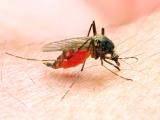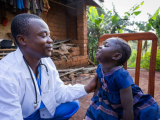Oct 6, 2004 (CIDRAP News) The first US case of Lassa fever since 1989 is a reminder that physicians need to consider exotic diseases when making diagnoses, noted the Oct 1 edition of Morbidity and Mortality Weekly Report (MMWR).
Lassa fever is rarely found outside of West Africa. But the case study published in the Centers for Disease Control and Prevention (CDC) publication points out that the ease of international travel has also made microbes mobile.
A Liberian businessman who lived in New Jersey but commuted to farms in Liberia and Sierra Leone fell ill during the final days of a 5-month stint in Africa in August, CDC reports said. Two days later he flew from Freetown, Sierra Leone, through London to Newark, N.J. He rode a train on the last leg of his journey.
Hours later the 38-year-old man was hospitalized in Trenton, N.J., for fever, chills, sore throat, diarrhea, and back pain. His temperature was 103.6°F. Physicians initially suspected malaria and typhoid fever, and treated him with antimalarials and antibiotics.
Despite treatment, the man's condition worsened. By his fourth day in the hospital, he was in respiratory distress. Doctors intubated and ventilated him, and reconsidered the initial diagnoses. This time yellow fever and Lassa fever rose to the top of the list, the report said. After notifying state health officials and consulting CDC, doctors arranged to give the patient ribavirin intravenously, under an investigational new drug protocol.
A few hours after that consultation on Aug 28, the patient died without receiving the ribavirin. Serum antigen detection, reverse transcriptase-polymerase chain reaction, and other tests confirmed he died of Lassa fever, only the 20th imported case to have been noted worldwide, MMWR said.
His death and diagnosis prompted an intensive search to find people with whom he had contact while ill. Multiple criteria were used to determine if that contact was high- or low-risk.
Of the 188 people who had contact with the man during his likely infectious period, five were classified as high-risk and 183 as low-risk. Those at risk included family members; nurses, physicians and lab workers at the Trenton hospital; lab workers at commercial laboratories in California and Virginia; and 19 fellow airplane passengers.
Seventeen of the 19 plane passengers were from the United Kingdom and two were Americans. Only three passengers could not be contacted. All the contacted passengers were healthy and had not suffered fevers within the 21-day incubation period for Lassa, MMWR reported.
The children of some at-risk patients were kept from school until the incubation period expired on Sep 18, MMWR said. No contacts contracted Lassa-like symptoms.CDC describes Lassa fever as an acute viral illness endemic to West Africa. It is named for the Nigerian town where two missionary nurses died in 1969. The zoonotic virus from the family Arenaviridae is mild or asymptomatic in about 80% of human victims. The other 20%, however, develop a severe, multisymptom disease that can include shock, hemorrhage, seizures, and death. Outbreaks can prompt case-fatality rates as high as 50%.
Rats in the genus Mastomys, which live throughout West Africa, host Lassa. The virus can be spread when people kill and eat the rats, when the rats contaminate poorly stored human food, when dust containing virus shed in urine or feces becomes airborne, and through people's cuts and sores. Lassa fever can also spread through contact with the fluids of a human victim. It kills about 5,000 people a year, CDC said. Estimates place the number of Lassa infections between 100,000 to 300,000 annually, with the caveat that regional surveillance is spotty, according to the report.
MMWR recommended that clinicians consider both common and uncommon diseases when evaluating patients who have traveled from Africa. Clinical histories must uncover travel to regions with uncommon endemic diseases, and lab work must be done quickly, the report added.
CDC. Imported Lassa fever: New Jersey, 2004. MMWR 2004 Oct 1;53(38):894-7 [Full text]




















